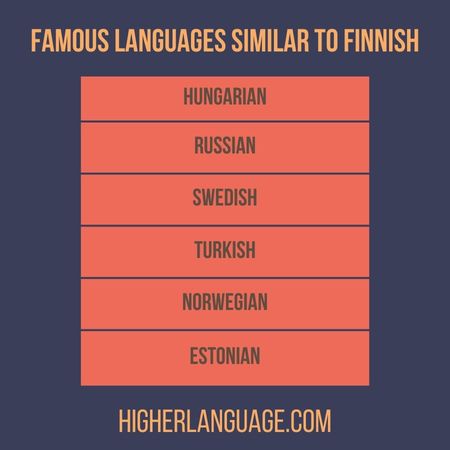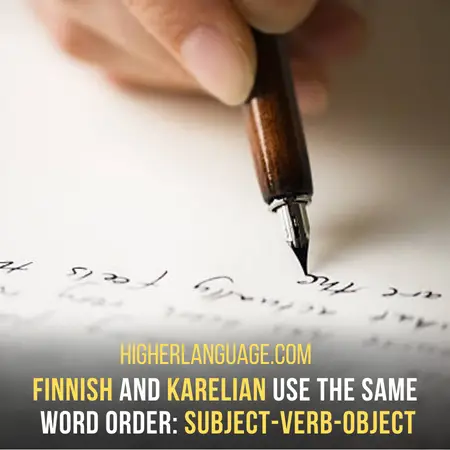The Finish is a unique and interesting language, but learning it may take some time. However, knowing languages similar to Finnish can help in this regard.
[toc]
We will share some languages that have similarities with Finnish. They are common in terms of grammar, vocabulary, and even sounds. So if you want more, keep reading!
Languages Similar To Finnish – 9 Options For You!
Finnish has become increasingly popular for a good reason! Although approximately 5 million people speak Finnish. You don’t have to relocate to Finland to learn the language.
There are several other languages similar to Finnish that you can also learn.
Today, we will discuss some of the best languages worth learning if you want to get a taste of Finland!
For example, Finnish is a member of the Finnic branch of the Uralic language family. This means that languages like Estonian and Hungarian might be good choices.
Languages like Russian and Swedish also share some similarities with Finnish in grammar.

So if you’re interested in learning languages similar to Finnish, any of these options could be a good fit.
These are just some of the options. There are more languages in the list of languages similar to Finnish. Read more to go deeper!
1. Estonian:
Estonian is the language of Estonia, a country located in Northern Europe.
It is a member of the Finnic branch of the Uralic language family. This means it shares some similarities with languages like Finnish and Hungarian.
For instance, Estonian has no gender and uses the Latin alphabet like Finnish.
It also has a similar word order to Finnish, with the verb typically appearing at the end of the sentence.
Moreover, both languages have a rich system of vowel harmony.
This means that words often have vowels that match in terms of frontness or backness. This affects the pronunciations.
Further, Estonian and Finnish have many loanwords from each other’s languages.
For example, the Finnish word for “sow-na” is sauna, which comes from Estonian. Similarly, the Estonian word for “reindeer” is põder, which comes from Finnish.
So, Estonian is a good option if you’re looking for language similar to Finnish.
2. Swedish:
Swedish is mostly spoken in Sweden, a country located in Northern Europe. Most people speak Swedish in Sweden as their first language making it popular.
Besides, Swedish is one of the languages most similar to Finnish. Both languages share many similarities in terms of grammar and vocabulary.
Both languages use the same alphabet and have very similar pronunciations. In fact, the Finnish alphabet was actually based on the Swedish alphabet.
Another similarity between these languages is that they both have many vowels.
Finnish has the most vowels of any language, with fifteen unique vowel sounds. While the Swedish own twelve. This is more vowel sounds than most languages.
In addition, Swedish has a similar word order to Finnish. In both cases, the verb always comes at the end of the sentence.
Thus, if you know one of these languages, grammar-wise, it’ll be easier for you to pick up the other.
3. Hungarian:
Hungarian is another language that is often compared to Finnish. These are both Finno-Ugric languages, which means they share a common origin.
Hungarian has a similar word order to Finnish, with the verb always coming at the end of the sentence.
For example, Hungarian and Finnish have different word orders than English.
In these languages, it is Object-Subject-Verb rather than the Subject-Verb-Object common in English. (Note: You can use both in Finnish)

Further, like Finnish, Hungarian also has many vowel sounds. So, Hungarian has the second most unique vowel sounds (after Finnish).
Another similar point is that these languages use the Latin alphabet, i.e., A, B, C…
If we analyze vocabulary, again, there is a similarity between these languages.
For instance, both languages have words like ‘kirja’ (book), ‘nainen’ (woman), ‘mies’ (man), ‘auto’ (car), etc.
Finally, both languages must be difficult for English speakers.
4. Russian:
Russian is also one of the widely spoken languages in Finland. This is because the land area of Finland is very close to Russia.
Although Russian and Finnish languages are quite different, there are still some similarities. Here, vocabulary is one of the main features.
For instance, you can find several words of Russian in Finnish, such as kapakka (bar), katu (street),
lähteä (to leave) etc.
Another similarity is that both have a heavy reliance on suffixes. Thus, suffixes can change a word’s meaning in Finnish or Russian.
For example, the word ‘read’ in Finnish is ‘lukea’, but if you add a suffix to it, it becomes ‘lukija’, which means ‘reader’. The same applies to Russian.
Also, they both don’t have articles. So, there is no word for ‘the’ or ‘a’. All these features make these languages alike to some extent.
5. Turkish:
At first, Turkish and Finnish may seem very different. But, on closer inspection, there are often many similarities.
Such as grammatical rules are the same, which makes it easy to understand others.
Like Finnish, Turkish is an agglutinative language. Turkish words form by adding different suffixes to the root word.
For example, ‘gelmek’ in Turkish means ‘to come’. But if you add the suffix ‘-iyor’, it becomes ‘geliyor’ which means ‘he/she is coming.
Similarly, Turkish uses vowel harmony like Finnish. So the words with certain vowels can only come with other words that have similar vowels.
For example, when using the word ‘kardeş’, which means ‘sibling’, you can only use other words with either front or back vowels.
You couldn’t use a word like ‘kitap’ (book), which has a mix of front and back vowels.

Thus, if you know Finnish, you’ll have an easier time learning Turkish grammar and vice versa.
6. Norwegian:
Norwegian and Finnish are both languages spoken in Scandinavia. And like Finnish, Norwegian also uses vowel harmony.
Both pay attention to what kind of vowels are next to each other in a word. Then, try to avoid having too many different kinds next to each other.
The main similarity between these two languages is that they both have a lot of cognates.
A cognate is a word that has the same meaning and origin as another word.
For example, the English word “father” and the Spanish word “padre” are cognates.
The same goes for Finnish and Norwegian cognates like “tyttö” (girl) and “jente” or “poika” (boy) and “gutt”.
Both languages allow for lengthy words. Like, you can combine many words in Finnish to create a new word. This is called compounding. Norwegian has the same feature.
Also, a similarity between these languages is that they both have a lot of dialects. This makes them both quite interesting languages to learn.
7. Votic:
Votic is a language that very few people speak, including most elderly.
It is a dying language with only around 500 speakers in the world. The language is closely related to Finnish and Estonian. It also belongs to the Uralic language family.
Like Finnish, Votic has vowel harmony and agglutination. This means that words are created by adding suffixes to a root word, and vowels within a word must agree.
For example, the word for ‘house’ in Votic is ‘maja’, but if you wanted to say ‘inside the house’, you would say ‘majas’.
Similarly, Finish has vowel harmony. So the word for ‘house’ in Finnish is ‘maja’, but if you wanted to say ‘inside the house’, you would say ‘majassa’.
The same example points to another similarity between these languages. Did you notice that the word for ‘house’ is same in both languages and uses Latin script?
Votic is in danger of extinction. So learning it would be a great way to help preserve it.
8. Karelian:
The Karelian language is very similar to Finnish. It exists in the Russian Republic of Karelia, situated next to Finland.
Finnish and Karelian are two mutually intelligible languages. If you know one, you can figure out the other.
You can find multiple similarities between them. First, they both use the Latin alphabet. Second, they have very similar grammar rules.
For instance, both languages use the same word order: subject-verb-object.

Third, both languages have a rich set of vowel sounds. This shows there are more vowel sounds in these two than in other languages like English.
Fourth, many words exist in the same way and have the same meaning in both languages. For example, the word for “house” is “talo” in Finnish and “tali” in Karelian.
Lastly, both languages have a large number of loanwords from other languages.
For instance, in Finnish, a word like “Kissa” (cat) is from Swedish, while in Karelian, a word like “läähkö” (ear) is from Russian.
This shows that both have a strong influence on foreign languages.
9. Sami:
The Sami language is part of the Uralic language family. It is also closely related to Finnish and Karelian.
Like Finnish and Karelian, the Sami language has a rich set of vowel sounds. This means more vowel sounds in these languages are present than in others.
Another point between Sami and Finnish is that they both have a grammatical case system. This means that words can change their form depending on their role in a sentence.
For example, the word for “cat” in Sami is different if the cat is the subject or the object of a sentence.
In the same way, Finnish has different words for “I” and “me”, depending on the subject or object of a sentence.
Also, they both rely on genitive cases to show possession. In addition, both languages have a system of suffixes that can add words to change their meaning.
Finally, like Finnish, Sami languages use the Latin alphabet.
Conclusion:
Finnish is the official language of Finland. It is different from many European languages, which share a common root.
However, some languages are similar to Finnish, including Estonian, Hungarian, and Turkish.
Although these languages share certain traits with Finnish, every language has unique features.
Remember that just because two languages are similar doesn’t mean they are intelligible. Still, similarities help you learn a new language more easily.
If you’re interested in learning Finnish, be ready for the challenges. However, this will be rewarding in the end.